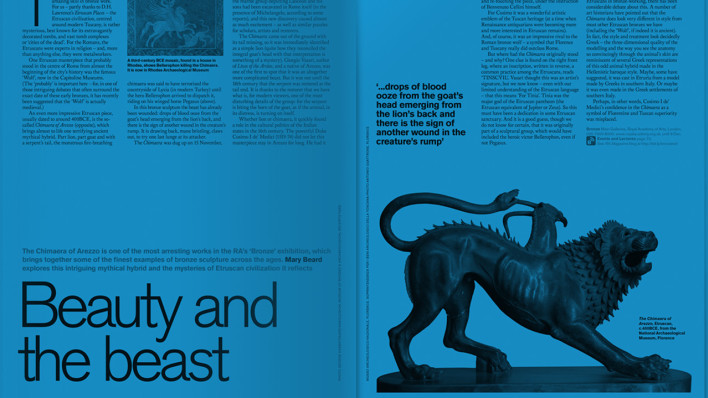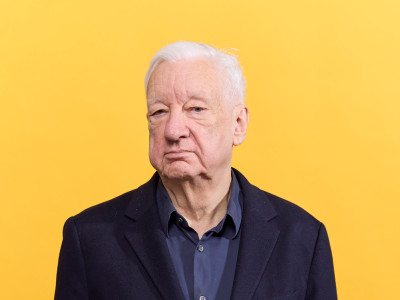
In the studio with Gary Hume RA
By Fiona Maddocks
Published on 10 November 2011
The Academician's Clerkenwell studio is cool, white and ordered - but in it Hume is a warm, unpretentious presence.
From the Winter 2011 issue of RA Magazine, issued quarterly to Friends of the RA.
Artist’s workplaces by no means always reflect their paintings. Exquisite miniatures can emerge from chaos, splashy canvases from pristine order. Gary Hume’s is an exception: his cool, immaculate, high-gloss paintings on aluminium chime perfectly with the chic, industrial simplicity of his split-level studio in Clerkenwell, London. Divided between semi-basement and street level, with concrete floors and white walls, this is his principal studio and, quite evidently, he loves working there.
When we meet, dozens of instantly recognisable Hume paintings – soon to go on show at White Cube’s Mason’s Yard and Hoxton Square galleries – cover every surface. Some are propped on paint tins, others stand on the floor. They show flowers and birds, faces and ghosts of ideas, some bright, some muted. With the White Cube shows, and an Arts Council Flashback touring exhibition in Leeds and Wolverhampton, Hume’s work will be prominent in several venues in early 2012.
If his studio matches his work, Hume himself is surprisingly different: rough-shaven and unselfconsciously scruffy, warm, humorous, refreshingly blunt, lacking in pretension. You sense a dark soul ready to leap out and ambush him, but Hume’s manner is quietly outgoing. He is ready to put this current work behind him and move on.
"I’ve been looking at all this for nearly two years. Now I’m thinking of new subjects – and as yet I’m not sure what – with some relief." He leaves the hanging of exhibitions to his wife, the artist Georgie Hopton, "basically because she’s much better at doing it, and more objective."
Hume came to Clerkenwell five years ago when he and his fellow artist Marc Quinn acquired the industrial units beneath a block of modern flats and had them converted. Hume also has a place in upstate New York, where he spends months at a time, and in Suffolk where his sculpture is produced.
His open-plan studio is uncluttered, with no books or postcards or other visual prompts. Brushes are neatly ordered by size, and stacked in pots or away in drawers. A dozen metal shelves house rows of commercial gloss paint, his favourite medium. While the tins are humdrum, the names are exotic: 'Moroccan Velvet', ‘Candy Love Pink’, ‘Jamaican Ginger’, ‘Frosted Green’.
Which way does the studio face? Hume is unsure and reaches for the compass on his smartphone to check. "Ah, it’s north," he grins, endearingly surprised that a purpose-built artist’s studio should have windows facing the ‘right’ direction. "There was a time when they were doing construction work across the road. When the old building was knocked down, the light was much harder to work in, too bright. Once the new one was in place, it suddenly became okay again."
Our photographer has snapped Hume in the north-west corner between his lush, velvety red-and-pink painting, Wunderbar, inspired by Klimt and, to his right, a child’s face in outline taken from Rubens, adorned with a large pink blob. To his left, out of view, is a small, blithely haunting face, painted at top speed.
"These represent the extremes of my working methods. Most of what I do is incredibly slow and painstaking, building up paint, waiting for it to dry, ensuring the lines are clean and sharp. But some paintings are done very fast in one take, in maybe five minutes or less – like a sprint in between marathons."
The fourth of five children, Hume was born in Kent in 1962 and, after his father left, was brought up by his mother. Unsurprisingly, Hume has said he wanted his own son, Joe, now a photographer in America and of whom he speaks smilingly, to know his father. He is quick to credit his independent-minded mother for her children’s shared sense of purpose.
Hume’s sister, Kate Blake, is his studio manager (one of two studio staff; the other assists on the paintings). All the siblings have done well: one brother is an inventor, another is high up in local government. "Mum was always very loving," he recalls. "There was never any self pity. She would say to us: 'You’re not bored, you’re boring!' That did the trick." Is she proud of his work? "Oh yes, she’s delighted. But she’s madly in love at the moment, so a bit preoccupied. She’s 80. He’s nearing 90."
After an uncertain start and a series of dead-end jobs, Hume studied at Chelsea College of Art and Goldsmiths. "Up until my early 20s I wasn’t really educated, and I was slightly dyslexic. I was totally lost for a while. Eventually, I realised that what I really liked, and all I was good at doing, was making things. But it took longer to realise that I could be an artist."
His breakthrough came with his series of Door paintings which caught the attention of Charles Saatchi. Soon Hume’s name was associated with the Young British Artists, first in the YBA showcase Brilliant! (1995) in the US and then, in 1997, in the Royal Academy’s Sensation show. In 2001 Hume was elected an Academician, the first YBA, though several have now followed. Did he mind being embraced, so young, by the so-called ‘artistic establishment’?
"No, I was really pleased. I had always loved the exhibitions though I was less in love with the Summer Show because – unlike private galleries – you’re not in absolute control of how your work is shown. But that’s no different from going into someone’s house and not liking the way they’ve hung your picture. You soon realise it’s wise to see the benefits!"
The title of Hume’s White Cube show is The Indifferent Owl. "Where I live in New York, there’s a wood. I heard an owl in the night," he explains. "Next day I found one of those 'Happy Birthday' balloons caught in the trees. It had almost deflated. I imagined the owl, utterly indifferent, watching the balloon float by as it slowly collapsed. That’s how I see life. I’m the owl, totally disengaged as the balloon bobs by…"
What does the balloon represent? "Just about goddam everything – global warming, congestion charging, coalition governments, everything!" He says this with unflinching conviction, and a passing nod at his younger self when he was more politically engaged. "The ‘theme’ for my current work is that it’s made with an innate indifference to anything other than trying to make something beautiful." Then his expression lights up as, in an instant, he deflates his high-blown metaphor. "But if that balloon had been a mouse, that owl would have swooped right down on it and torn it to pieces. That’s how I am – indifferent except to the things which really matter to me."

Enjoyed this article?
"As well as free entry to all of our exhibitions, Friends of the RA enjoy one of Britain’s most respected art magazines, delivered directly to your door.
Why not join the club?"
Related articles

5 of the best uses of colour in art and culture
18 September 2024

Michael Craig-Martin: living colour
28 August 2024
